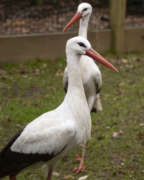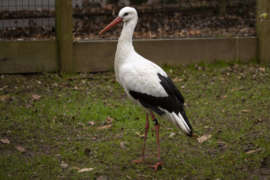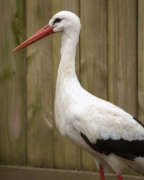White Stork
White Stork
When you think of storks, you most likely picture a European white stork. These large birds are most closely related to herons, bitterns, ibises, spoonbills, the shoebill, and the hammerhead.
Ciconia ciconia
Carnivore
Africa, Europe [VIEW MAP]
Grasslands, Wetlands
European white storks spend much of their time using their long bills to forage in tall grasses or shallow waters.
Photos and Videos
Storks have held symbolic meaning in cultures around the globe for so long that we don’t know how these beliefs originated. The myth of white storks delivering babies likely originated in northern Europe. After wintering in Africa, storks return to Europe to breed in the spring, when many human couples who wed during the previous summer were welcoming babies of their own.
As their name suggests, the feathers of the European white stork are primarily white or off-white with the exception of their primary wing feathers, which are black. They sport a red, dagger-like bill which is used to forage in tall grasses and wetland environments. Their long, red legs help keep their bodies warm while wading and foraging in water.
These migratory birds breed in Europe and southwestern Asia in the spring. In some cultures, storks represent fidelity, as bonded pairs often mate for life. Both parents help build a nest, which is often used year after year, from sticks and straw. They lay three to five eggs, which are incubated for about a month. Both parents care for the chicks, who fledge about two months after hatching.
European white storks spend much of their time using their long bills to forage in tall grasses or shallow waters.
The European white stork breeds in Europe during the spring and remains there until late summer. In August or September, they migrate in large flocks with the assistance of thermal updrifts to various parts of Africa.
This species prefers open areas such as grasslands, shallow marshes, lagoons, and floodplains.
European white storks are opportunistic carnivores, meaning they’re likely to sample just about anything they encounter. Common prey includes small mammals such as mice and voles; large insects such as beetles and locusts; various amphibians, snakes, lizards, fish, mollusks, and crustaceans; and occasionally eggs or nestlings of ground-dwelling birds.
This species is heavily dependent on wetland environments, which face challenges of habitat loss and degradation from drainage and pollution. You can help by shopping for sustainably harvested seafood, which means it hasn’t degraded natural habitats.
Zoo Atlanta’s Horticulture Team helps protect northeast Georgia mountain bogs, a critically endangered wetland habitat, by assisting the Georgia Department of Natural Resources and The Nature Conservancy in restoration efforts.




